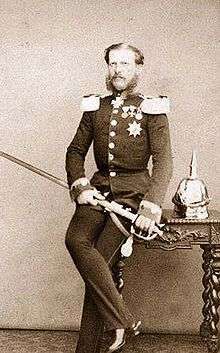Duke William of Mecklenburg-Schwerin
| Willem of Mecklenburg-Schwerin | |
|---|---|
 | |
| Predecessor | Paul Frederick |
| Successor | Frederick Francis III |
| Born |
5 March 1827 Ludwigslust |
| Died |
28 July 1879 (aged 52) Heidelberg |
| Spouse | Alexandrine of Prussia |
| House | House of Mecklenburg-Schwerin |
| Father | Paul Frederick, Grand Duke of Mecklenburg-Schwerin |
| Mother | Alexandrine of Prussia |
Willem of Mecklenburg-Schwerin (Ludwigsburg, March 5, 1827 - Heidelberg, July 28, 1879), was the second son of Hereditary Grand Duke Paul Friedrich of Mecklenburg and his wife Princess Alexandrine of Prussia, daughter of Frederick William III.
Life
He enlisted in the Prussian army and became commander of the sixth regiment of cuirassiers. William had a reputation for drunkenness and a dissolute character. On two occasions he was deprived of his command in the Prussian army and he proposed marriage to the celebrated ballerina Marie Taglioni consequently he was generally considered to be the "black sheep" of the family.[1] Under family pressure, on 9 December 1865, he married Alexandrine of Prussia, daughter of Albert of Prussia and Marianne of Orange-Nassau. William settled with his wife at Bellevue Palace in Berlin. The marriage was unhappy and the couple had an only child: Charlotte (1868-1944) who married Prince Heinrich XVIII Reuss of Köstritz.
William took part in the Austro-Prussian War of 1866 as a major general in command of a brigade of cavalry corps. He managed with difficulty to secure an unimportant command in the Prussian army during the Franco-Prussian War, but he was wounded on September 9, 1870 in Laon. As a result, he was long absent from the front and he showed a great lack of energy at the Battle of Le Mans. In 1873 he became commander of the 22nd Division in Kassel, completed in 1874 but it was only an honorary position. He died on July 28, 1879.[1]